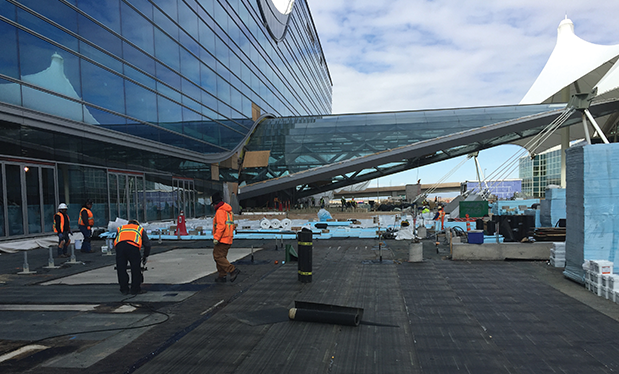In March, NRCA published Guidelines for Air Retarders in Roof Assemblies, a new document that provides an overview of the energy code's air barrier requirements, industry-conducted research and NRCA's recommendations for designers about air retarders in roof assemblies.
Terminology
The term "air barrier" used in standards and energy codes (and by some in the construction industry) is somewhat of a misnomer. Many construction materials and assemblies have been tested and shown to have low air-permeance values but not zero permeance as the term "barrier" implies. Therefore, NRCA prefers and recommends the term "air retarder" except when specifically quoting code language. NRCA suggests others in the roofing industry also adopt this more accurate terminology. The construction industry has taken a similar stance when referring to vapor retarders, which are known to have low but not zero vapor permeance.
Document overview
Guidelines for Air Retarders in Roof Assemblies' Chapter 1 provides an overview of code provisions applicable to air retarders in roof assemblies. The first recognized criteria for air retarders in buildings appeared in ASHRAE 90.1-2010, "Energy Standard for Buildings Except Low-Rise Residential Buildings."
The International Energy Conservation Code,® 2012 Edition (IECC 2012) contained the first codified requirements for air retarder use in building envelopes, including roof assemblies. IECC 2012 requires testing building materials (products), building assemblies (roof systems) or whole buildings to prescribed maximum allowable air-permeance requirements. IECC 2012 also includes a "deemed to comply" option, which exempts specific materials and assemblies from testing based on their known low air permeance. The deemed to comply option permits spray polyurethane foam (SPF), built-up membrane, polymer-modified bitumen membrane and adhered single-ply membrane roof systems when installed as air retarders with sealed perimeters and penetrations.
IECC 2012 also references ASHRAE 90.1-2010 as an alternative compliance path. When originally published, ASHRAE 90.1-2013 contained air retarder provisions similar to those contained in ASHRAE 90.1-2010.
IECC 2015's air retarder testing requirements and deemed to comply option are similar to (but reformatted from) those contained in IECC 2012. ASHRAE 90.1-2013 is included as an alternative compliance path.
One notable change between IECC 2012 and IECC 2015 is the applicability of the codes' air retarder requirements. It can be interpreted IECC 2012's air retarder requirements apply in new construction and reroofing. In IECC 2015, specific exceptions have been added excluding the code's air retarder requirements when roof re-covering or " … roof replacement where the alterations or renovations to the building do not include alterations, renovations or repairs to the remainder of the building envelope."
Chapter 2 discusses four NRCA-supported laboratory research projects that document membrane roof systems function as effective air retarders. The research also shows a seam-fastened, mechanically attached single-ply membrane roof system can function as an effective air barrier. References to the specific research reports are provided in the document's appendix.
Chapter 3 provides NRCA's best-practice recommendations for air barrier design. With SPF and membrane roof systems, a roof covering can function as an effective air retarder provided perimeters and penetrations are addressed properly. Other roof system types typically will require a separate air retarder layer be incorporated into the roof assembly.
Building and roof system designers clearly are responsible for proper air retarder design. A project's construction documents should denote locations of air retarder components throughout the building envelope; air retarder materials; methods of application; and details of any penetrations, terminations or transitions. Special attention needs to be paid to the design and construction sequencing of any air retarder transition details or conditions, such as where an air retarder incorporated into a roof assembly transitions into and interfaces with a wall assembly air retarder. The document includes several figures designers can use to develop project-specific air retarder details.
Get it
NRCA's new air retarder document is available to members free as a PDF download by accessing NRCA's bookstore at shop.nrca.net or via NRCA's app, which is available in the Apple App Store and Google Play.
A hard-copy version of the document is available for purchase from shop.nrca.net.
Mark S. Graham is NRCA's vice president of technical services.



